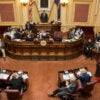Spain has spent nearly $30 billion on its green energy economy; each one of these green jobs cost the Spanish government on average $855,000, but the return on investment hasn’t been great. The country’s unemployment rate is not decreasing but rapidly increasing and is now at 19.3%, which is one of the highest in the developed world.
In fact, the government’s heavy investments in the solar industry created a bubble than did more to harm to the solar industry than helping it:
Though wind power remains the dominant alternative energy here, the government introduced even more generous inducements in recent years to help develop photovoltaic solar power — a technology that uses sun-heated cells to generate energy. Lured by the promise of vast new subsidies, energy companies erected the silvery silicone panels in record numbers. As a result, government subsides to the sector jumped from $321 million in 2007 to $1.6 billion in 2008.
When the government moved to curb excess production and scale back subsidies late last year, the solar bubble burst, sending panel prices dropping and sparking the loss of thousands of jobs, at least temporarily.”
And yet, back at home, at the recent House Select Committee on Energy Independence and Global Warming, legislation, 4 out of 5 testifiers advocated more government support such as tax credits, increased federal funding for solar research, more freedom to develop solar on public lands, and the adoption of a “green bank” which would do much to fund solar power. Frank De Rosa made the important point that a key element in the forging of a solar renaissance in America is to place a price on carbon to even the playing field:
Because the cost of carbon emissions has not been incorporated into the price of fossil generation, such generation appears cheaper than renewable energy. Not surprisingly, utilities try to keep their rates as low as possible. Thus, renewable energy appears to be more expensive. Reducing the up-front cost of renewable generation will close the gap between fossil fuels and renewables and thus increase utilities’ procurement of renewable resources”
Only one panelist, Dr. Gabriel Calzada, provided a cautionary tale, warning members of congress to learn from his country’s mistakes: Spain’s solar ‘renaissance,’ which was meant to stimulate the economy with thousands of new green jobs, has instead done massive damage to the spain economy. The problem stems from Spain’s enormous investment in government subsidies for green energy, which created an artificial market that can only survive with the continuation of billions of dollars being pumped into it. According to Dr. Calzada, Spain spends about $8 billion a year on green energy subsidies but the result is that for every green job created 2.2 jobs were lost because so much money was taken out of viable parts of the economy and put into a more unreliable green market—solar did not even make up 1% of Spain’s entire energy production in 2008.
It is no secret that Obama sees Spain as a model for the creation of America’s green economy. As he said in an Ohio speech, January 16, 2009, Spain, Germany and Japan are “surging ahead” of the United States in green energy development not because they are “smarter than us or work harder than us” but most importantly, because “their governments have harnessed their people’s hard work and ingenuity with bold investments.” Climate legislation will harness ingenuity and innovation to the point that the government will dictate what energy resources Americans can develop; the government will dictate how this energy is produced, and the government will dictate how much it will cost.
While such harnessing did not do Spain’s economy well, it is worth pointing out that heeding Calzada’s advice is not to say that solar energy should be thrown to the wayside. Americans can benefit greatly from a diverse energy portfolio if it can survive the free market test and provide Americans with affordable electricity.
But if solar is promoted with mandates, tax credits and subsidies at the expense of more reliable sources, the American economy, like Spain’s green economy, will suffer from sunstroke along the way.
After the presentations, Congressman Markey and his colleagues explained to Dr. Calzada that the United States—although following in the footsteps of Spain—will manage to avoid the consequences that Spain suffered. But when energy prices and taxes go up to pay for an artificially created green economy, can we really expect a better result?
Katie Brown contributed to this post.






























9 Replies to “Spanish & Solar: A Model to Follow or a Cautionary Tale?”